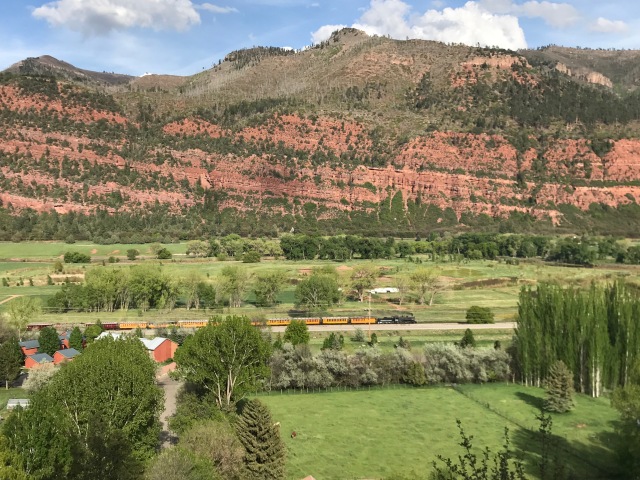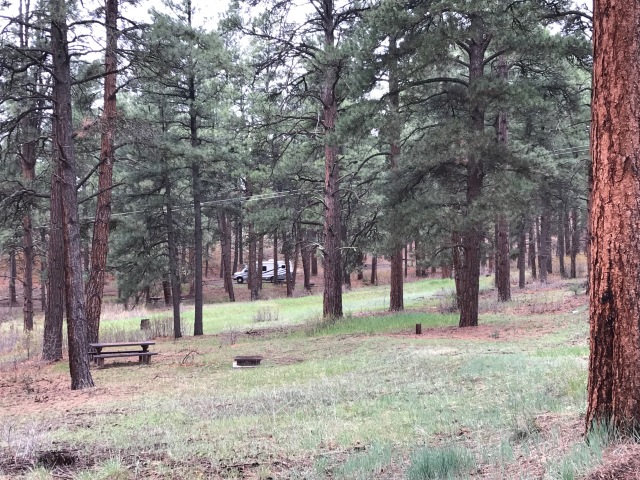Acclimating to the altitude, beauty and history
We’ve been at 6,000+ feet for a week now, and the altitude seems to be little problem now. Have been up to 11k without headaches or intolerable shortness of breath, but we still drink lots of water and keep the caffeine to a minimum. So far, so good.
Getting used to the eye-popping beauty is another matter. Don’t know if we’d ever stop sucking in our breath at the snow-capped 14ers (mountains of 14,000’). They’re a constant reminder of the scale, majesty and endurance of Mother Earth. Keeps you humble.
We took the old Durango-Silverton narrow-gauge train a couple days ago, and it was quite magical. Reminded us of the cogwheel train up to the Jungfraujoch in Switzerland, but much quieter. The train covered 50 miles and 3,000 feet of climb in about 2.5 hours (the 100-year-old track prevents faster speeds). Carried two skiers on board who disembarked at Rock Creek to camp and climb to the snow to stretch their season to the max.
Arrived in Silverton, an 1880’s mining town that hosted Wyatt Earp, Doc Holiday and Bat Masterson (Silverton jailor) way back when, and had a nice lunch at the hotel where the three of them gambled. Silverton is a fly stuck in amber: very little has changed, cosmetically, since the 19th century. Every street is still dusty clay, every old building is historically preserved, and you can still see the mine tailings on the surrounding slopes. Feels like the frontier, but at 10,000 feet. Even Notorious Blair Street, full of houses of ill repute, makes good business promoting the history of the “ladies with negotiable affections.”
We met a wonderful Native American crafts merchant in Silverton in her tiny store, and she introduced us to her family’s history of selling crafts since the early 20th century. Each winter she goes to 28 pueblos to buy for her store, and we were her first sale of 2017 (store opens each year in early May). We purchased a Zuni bear fetish rendered in Bumblebee Jasper. Arlene, you have the best goods in town!
The bus ride back made better time, landing back in Durango in 80 minutes. It passed gorgeous landscapes, peaks and valleys still ensconced in snow, while down in town, it was already summer, at 78 degrees with flowers and trees in full bloom. Side note: you can see three different lateral moraines as you drive south into Durango. Evidence that this area saw three different glacial periods in the past 100,000+ years.
The limited hikes we could squeeze in made us hungry for more hiking than fits into three days. We caught the Colorado Trail Kennebec Section along Junction Creek and saw a prolific number of falls in a short distance.
Of course, you get the best of the rushing water in May and early June, so it was a real treat to hear the thundering water all along the path. Unlike on the Appalachian trail, we didn’t meet any through-hikers this time, but we’re convinced that Colorado’s #1 pastime is dog-walking, as every human has at least two if not three dogs along.
We also hiked the Falls Creek Trail behind our campground, which was a stunning 4-mile loop leading past a roaring waterfall (we forded the waterfall on a narrow log (that’ll get your heart going), through spruce forests and aspen glens, over a spring meadow full of boggy spots, and out to a prominent overlook of the Animas River before the path finally snaked its way through lupine glades back to the trailhead. Wondrous. The plants we saw included lupines, wild larkspur, chokecherry, serviceberry and hackberry, the fattest juniper berries we’ve ever seen, bluebells and potentilla.

The red siltstone, grey slate and tan and white sandstone slopes and mesas of the San Juan Mountains are on display everywhere around Durango, and we couldn’t get enough. The red rock is called Chinle siltstone, from the upper Triassic period (230 million years ago), and it is my favorite. I love the dark red kidney bean color, and would love to see it mixed into clay and shaped into a pot. It’s a very soulful shade.

We’ll go back to Durango again. Definitely. We’d been hearing about it for 30 years, and now we know what friends were raving about.
Reservations for a dig at the Crow Canyon Archaeological Center of Cortez are calling, so we left Durango for the southwestern-most corner of this beautiful state on Sunday, Mother’s Day. George treated me to a visit at the Anasazi Heritage Center, where visitors are acclimatized to the need to treat all paths, plants, ruins, stones and nature with ultimate respect. Basically, you don’t get your maps to the hiking trailheads until you understand your own responsibility to respect and protect the sites.
This was followed by a gorgeous hike in the Canyons of the Ancients, where the desert was bursting with color and two splendid cliff dwellings could be seen from the path. Spellbinding. Plants here included hedgehog cactus in bloom, cushion daisies, more larkspur, cardinal flower, calendula, stattice, sego lily, white erigonium, globe mallow, penstemon, apache snakeroot, pygmy serpentweed, brown-eyed susans, ranunculus, shortleaf rockpink, torch lily and stonecrop. Locals say this year’s bloom are due to the great winter and rainy spring they’ve had. What luck!


































